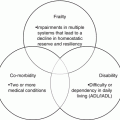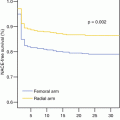Clinical diseases are as follows:
Myocardial infarct, congestive heart failure, peripheral vascular disease, cerebrovascular vascular disease, dementia, chronic obstructive pulmonary disease, connective tissue disease, ulcers, mild liver disease, diabetes mellitus type 2, hemiplegia, moderate/severe renal insufficiency, diabetes with end organ damage, tumor, leukemia, lymphoma, moderate/severe hepatopathy, metastatic tumor, AIDS
Table 4.2
Weighting of the “Charlson Comorbidity Index” for 19 contributing diseases
Weighting | Comorbidity |
|---|---|
1 | Myocardial infarction, congestive heart failure, peripheral vascular disease, cerebrovascular vascular disease, dementia, chronic obstructive pulmonary disease, connective tissue disease, ulcers, mild liver disease, diabetes mellitus type 2 |
2 | Hemiplegia, moderate/severe renal insufficiency, diabetes with end organ damage, each tumor, leukemia, lymphoma |
3 | Moderate/severe hepatopathy |
6 | Metastatic tumor, AIDS |
The Charlson Comorbidity Index has the advantage that it is very clearly structured and easy to complete, since the criteria are easy to identify and differ from each other well. An advantage is that it can be determined without patient survey, so only with the help of the medical record, and only slightly takes time for gathering and analyzing data (about 5 minutes). The index can be optionally used with and without age correction, and is validated for oncology patients. The Charlson Comorbidity Index has now been adapted to the use of administrative data (e.g. ICD-9 codes) [36, 37]. It is characterized by a very good reliability, excellent correlation with mortality and progression-free survival. The test-retest reliability, i.e. the degree of consistency of test results in the same subjects and with the same test in several testings, is good and the inter-rater reliability, i.e. the extent of the consistency of assessment results for different observers, is moderate to good [13]. A limitation of the index is that it only interrogates nineteen diseases. It does not take account of non-malignant hematological diseases (e.g. anemia).
Cumulative Illness Rating Scale
Another methodological approach to measure multimorbidity is the “Cumulative Illness Rating Scale” [38]. The “Cumulative Illness Rating Scale” aims to detect the physical deterioration of the patient by the estimated damage of 13 body systems using a five-point severity scale [25]. The “Cumulative Illness Rating Scale” was developed to assess the total medical burden and capacity for elderly patients to survive and was not originally designed as a comorbidity index [16]. Miller and colleagues revised the “Cumulative Illness Rating Scale” to take account of the problems of the elderly in long-term care. In 1992, they renamed the index in “Cumulative Illness Rating Scale for Geriatrics”, abbreviated CIRS-G [39]. This quantitative scale is used to detect the state of health of institutionalized frail older adults. Based on the examination of the patient and the available document, the doctor or nurses evaluate each of 14 organ systems, whether and to what extent it is affected by damage, malfunctions and activity impairment (see Table 4.3).
Table 4.3
“Cumulative illness rating scale”
Value 0–4 | |
(a) Cardiac (heart only) | ___ |
(b) Hypertension (rating is based on severity; affected systems are rated separately) | ___ |
(c) Vascular (blood, blood vessels and cells, marrow, spleen, lymphatics) | ___ |
(d) Respiratory (lungs, bronchi, trachea below the larynx) | ___ |
(e) EENT (eye, ear, nose, throat, larynx) | ___ |
(f) Upper GI (esophagus, stomach, duodenum, biliary and pancreatic trees; do no include diabetes) | ___ |
(g) Lower GI (intestines, hernias) | ___ |
(h) Hepatic (liver only) | ___ |
(i) Renal (kidneys only) | ___ |
(j) Other GU (ureters, bladder, urethra, prostate, genitals) | ___ |
(k) Musculo-skeletal-integumentary (muscles, bone, skin) | ___ |
(l) Neurological (brain, spinal cord, nerves; do not include dementia) | ___ |
(m) Endocrine-Metabolic (includes diabetes, diffuse infections, infections, toxicity) | ___ |
(n) Psychiatric/Behavioral (includes depression, anxiety, agitation, psychosis, not dementia) | ___ |
The 14 organ systems include heart, high blood pressure and vascular, hematopoietic and lymphatic system, lungs and respiratory tract (below the larynx), eye and ear, nose and throat medicine (eyes, ears, nose, pharynx, larynx), upper gastrointestinal tract (esophagus, stomach, duodenum, without a pancreas), the lower gastrointestinal tract (lower digestive tract, hernia), liver, gall bladder and pancreas, kidneys (without urinary tract, bladder and prostate), urogenital tract (ureters, urinary bladder, urethra, prostate, genital organs, uterus, ovaries), musculoskeletal and skin, nervous system (brain, spinal cord, nerves, and without dementia and depression), endocrine, metabolic disorders and breast disorders (including various infectious diseases and poisoning) and mental disorders (including dementia and depression). The rating is intuitive and is based on the description of the rating criteria from zero to four (see Table 4.4).
Table 4.4
Weighting of 14 for “Cumulative Illness Rating Scale” contributing organ systems
Rating scale | Rating criteria |
|---|---|
0 | No impairment to that organ/system |
1 | Mild: Impairment does not interfere with normal activity; treatment may not be required; the prognosis is excellent |
2 | Moderate: Impairment interferes with normal activity; treatment is needed; the prognosis is good |
3 | Severe: Impairment is disabling; treatment is urgently needed; prognosis is guarded |
4 | Very Serious: Impairment is life threatening; treatment is urgent or of no avail; prognosis is grave |
The end result of “Cumulative Illness Rating Scale” is the sum of each of the 14 individual organ systems score. The scale can vary theoretically between zero and 56 points, although a very high score is impossible because it would represent multiple organ system failures that are not compatible with life [40].
“Cumulative Illness Rating Scale” has good interrater reliability with correlation coefficients in the range from 0.55 to 0.91 [41]. The retest reliability is good [13]. Some studies have also documented a good predictive validity for mortality and autopsy [42–44]. One study showed a significant association with the risk of hospitalization in the following year [41]. Another study reported good discriminant validity, i.e. the measurements differ from each other by different constructs [39]. “Cumulative Illness Rating Scale” is one of the few validated instruments that can be used to quantify the multimorbidity in research [45]. Before using the “Cumulative Illness Rating Scale” it should however be reviewed to what extent the design of a planned study corresponds to the original study population of the index [16].
Index of Coexisting Disease
The “Index of Coexisting Disease” was first developed in 1993 by S. Greenfield to assess comorbidity in patients with malignant tumors (see Table 4.5). Later, the “Index of Coexisting Disease” was used for other patient categories. This method helps in calculating the length of stay of a patient in the hospital and the risks of repeated reception thereof in the hospital after surgery. For the assessment of comorbidity, the “Index of Coexisting Disease” evaluated separately the patient’s condition by two different components: Physiological and functional properties. The first component – “Index of Disease Severity” – measures the severity of sixteen concomitant diseases, each of which is rated on a 4-point scale, with zero being the absence of disease and three indicating the most severe form of the disease (see Table 4.6).
Table 4.5
“Index of Coexisting Disease” with its two components: “Index of Disease Severity” and “Index of Physical Impairment”
Index of disease severity | Index of physical impairment |
|---|---|
Ischemic heart disease | Circulation |
Arrhythmias | Breathing |
Other heart diseases | Neurological function |
Hypertension | Mental function |
Cerebral vascular disease | Urinary continence |
Peripheral vascular disease | Fecal continence |
Diabetes mellitus | Nutrition |
Respiratory diseases | Walking ability |
Malignancy | Eyesight |
Hepatobiliary disease | Hearing |
Gastrointestinal illness | Language skills |
Neurological disease | Arthritis |
Hematologic disease | |
HIV/AIDS | Anticoagulation |
Severity | “Index of disease severity” |
|---|---|
0 | No, state absent |
1 | Minimal or no morbidity |
2 | Symptomatic, active, but controlled, requires continuous treatment |
3 | Moderate, severe manifestations despite treatment |
The second component – “Index of Physical impairment” – focuses on the co-morbidity caused by the functional restrictions. It assesses eleven defined functional areas with a 3-point scale, where zero means normal functionality and two repealed functionality (see Table 4.7




Stay updated, free articles. Join our Telegram channel

Full access? Get Clinical Tree







